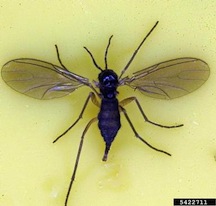In the cold Northeast, heat costs money. And no one knows it better than greenhouse growers. With Mother’s Day just around the corner, growers are ramping up for one of their biggest sales days of year — which until now, has meant cranking up the thermostat.
Not any more. Growers want to save money and fuel. The unanswered question? How will pests — and the biological controls that help keep them in check — respond?

Take fungus gnats. These sneaky little flies lay tiny little eggs just below the soil surface. Before long their larvae are out and about, burrowing through the soil and nibbling off every growing root tip they bump up against. But if en route these fungus gnat larvae bump up against parasitic nematodes, invisible threadlike critters that eat them inside-out … well, that’s why savvy growers have turned to nematodes to even their odds in the plant-survival department.

Cooler temperatures slow down both gnats and nematodes. If nematodes lag too far behind their larval prey under those conditions, we need to know. Our business, after all, is providing growers the best real-time information and guidance we can. Naturally, growers who provide real-world research settings for us are invaluable partners — because if it works for them, it’s likely to work for their peers.
We’ll collect lots of sticky cards over the season to help track how many fungus gnat adults squeaked past the nematodes compared to those in our control zones: the no-nematode and low-temp sectors. If our numbers come close to the numbers we got in our preliminary growth-chamber experiments earlier this year, we’ll be happy. Very happy.
